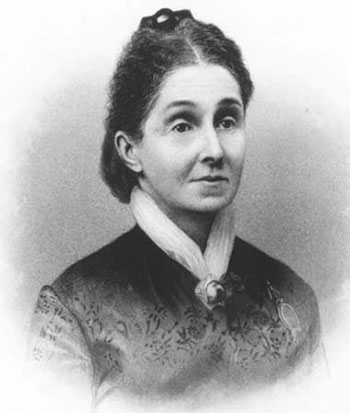
On a brisk autumn morning in October 1872, an elegant and determined woman opened the door to the Board of Election offices in downtown St. Louis and gracefully stepped inside. Beside her walked her husband of twenty-nine years, a respected attorney in St. Louis who supported his wife on all counts in what she had set out to do that morning.
The Presidential election of 1872 between Ulysses S. Grant and Horace Greeley was just three weeks away, and the office the couple entered that morning was bustling with activity. And in the thick of that bustle sat the 6th Ward of St. Louis Registrar of Voters, a fifty-two year old man named Reese Happersett.
When Reese Happersett looked up and identified the two people who had just entered his office that morning, it’s very possible that he thought to himself:
“Oh shit. Here we go.”
In all likelihood, Happersett recognized Virginia Louisa Minor and her husband Francis right away. Well-known in St. Louis political circles, the two had been vocal leaders in the women’s suffrage movement locally and nationally for several years. He must have also realized immediately why Virginia Minor had entered his office that morning. She had plans to vote in the upcoming Presidential election.
What caused that brief moment of foreboding to float through Happersett’s mind is that it was his job to tell Virginia Minor that she wouldn’t be able to. Virginia Minor was a female, and Missouri law in 1872 explicitly stated that only males could vote.
After the dust settled that morning, newspaper accounts reported that Reese Happersett politely declined Virginia Minor’s request to have her name added to the list of registered voters. Minor pushed back at Mr. Happersett’s rejection to a degree, but she had no plans to play the role of someone “creating a sensation” that day. In fact, not only did Virginia Minor know her request would be denied, she hoped it would be. If Reese Happersett denied her right to vote, the first step in her grand plan would be initiated.
The second step would be to take Reese Happersett to court.
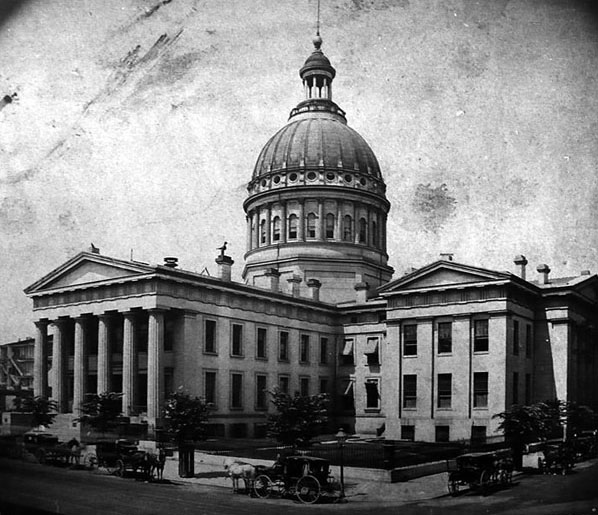
Perhaps more than any extant structure in St. Louis, the Old Courthouse embodies the deep and rich history of St. Louis.
The Old Courthouse is locally renowned as the building where Dred and Harriett Scott began their legal quest for freedom in 1846. Not nearly as well-known, but nearly as significant, Virginia Minor’s battle for women’s equality was initiated in the same building. Virginia Minor’s story played out on the same floors, within the same walls, and under the same dome as Dred Scott’s.

As they’d be known in the annals of the United States Supreme Court, Dred Scott v. Sanford and Minor v. Happersett share striking similarities. Both cases were first argued at the Old Courthouse in St. Louis. Both cases dealt with the issues of civil rights and equality. Both cases questioned the Constitutional definition of the “citizen”. Both cases were lost and appealed until they stood before the United States Supreme Court. And in both cases, that court would hand down decisions ruling against the plaintiff.
However, despite the judgements against Dred Scott and Virginia Minor, their respective movements both enjoyed booming support and increased activism in the wake of defeat. Both movements also eventually succeeded, but in one final and unfortunate similarity, both Dred Scott and Virginia Minor would not live to see it with their own eyes.
Virginia Minor was born on March 27, 1824 in Goochland County, Virginia. As a young woman, Virginia was educated at home and briefly attended an academy for young ladies in Charlottesville. She was beautiful, intelligent, known for having “ladylike manners” and possessing an “old-fashioned charm”. At the age of nineteen, she married her distant cousin Francis, which fortuitously enabled her to keep her maiden name. After a brief residence in Mississippi, the couple moved to St. Louis in 1845 and purchased a farm on land that is now the Central West End.
Despite her southern upbringing, Virginia Minor was committed to the abolition of slavery and an unflinching supporter of the Union during the Civil War. In late 1861, she was one of the first women to join the newly formed St. Louis Ladies’ Union Aid Society. This group, along with the Western Sanitary Commission, worked tirelessly to support wounded Union soldiers and their families during the war. Virginia Minor volunteered her own time and resources caring for patients at local hospitals, donating produce grown at the Minor farm, and even delivering jars of cherry preserves to men stationed at Jefferson Barracks.
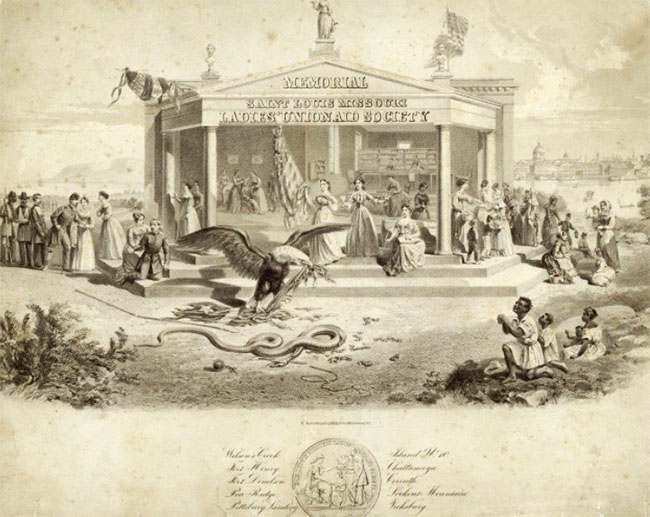
A significant side-effect of the Ladies’ Union Aid Society was that it enabled women such as Virginia Minor to showcase leadership qualities. As a result, the role of women in society suddenly expanded as women became more involved in causes outside of the home. Not surprisingly, many women involved in the Ladies’ Union Aid Society became leaders in the women’s suffrage movement. This was the path taken by Virginia Minor, and by the end of the war, she had committed her life’s work to the political enfranchisement of women.
Virginia Minor’s strong leadership skills would be rewarded in 1867 when she was named President of the newly formed Woman’s Suffrage Association of Missouri. This organization holds the distinction of being the first organization in history dedicated solely to the political enfranchisement of women. It wasn’t until two years later when Elizabeth Cady Stanton and Susan B. Anthony founded the National Woman Suffrage Association.
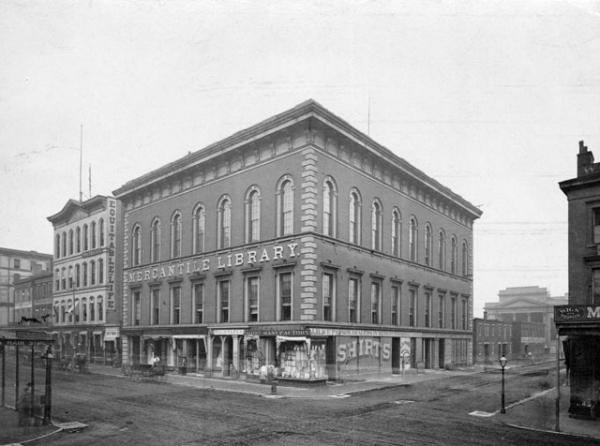
In the aftermath of the Civil War, the “Reconstruction Amendments” proposed to Congress generated a significant amount of protest from many leaders in the women’s suffrage movement. They demanded that these amendments, authored to grant former slaves rights under the United States Constitution, should be expanded to grant the same rights to women. Virginia Minor petitioned the Missouri State Legislature to do just that, but her proposal was barely considered. Her motion to add the word “women” to wording that gave blacks the right to vote in the 15th Amendment was soundly defeated by a vote of 89-5. Yet despite this another other setbacks, it was Virginia Minor’s husband who recognized a unique opportunity in the wording of the 14th Amendment. Without mentioning gender specifically, he theorized the amendment was written in such a manner than it legally granted women the right to vote.
In 1869, a national convention for women’s suffrage met in St. Louis at the Mercantile Library Building. It was at this convention where Francis Minor laid out this new legal theory. Backed by an impassioned speech from his wife, the convention formally adopted the principles of Francis Minor’s argument. Three years later, the theory would be put to the test when Virginia Minor attempted to register to vote in Reese Happersett’s office.
Laura Staley, in an article written for Gateway Heritage Magazine published in 1983, concisely illustrates the three key points Francis Minor used in his argument. The basis of it was that women already had the right to vote. All they had to do was exercise it.
 The Minor’s plan all along was to legally test the theory in court. To do so, Francis Minor filed a civil lawsuit against Reese Happersett in December 1872. Since women were not allowed to file suit on their own behalf, Virginia was named as co-plaintiff. The suit demanded that Reese Happersett be ordered to register Virginia Minor to vote and pay damages in the sum of $10,000.
The Minor’s plan all along was to legally test the theory in court. To do so, Francis Minor filed a civil lawsuit against Reese Happersett in December 1872. Since women were not allowed to file suit on their own behalf, Virginia was named as co-plaintiff. The suit demanded that Reese Happersett be ordered to register Virginia Minor to vote and pay damages in the sum of $10,000.
The Minors contended that Happersett was depriving Virginia Minor of a privilege of United States citizenship, and that his action was condemning her to a “position of involuntary servitude”. In response, Reese Happersett and his attorney simply claimed that he had simply enacted a provision of the Missouri State Constitution that included one definitive word: male.

Happersett’s attorney bolstered the defense by arguing the amendment was written for the purpose of granting blacks, and only blacks, the right to vote. The trial was not by jury, and both sides presented their arguments in written statements. Judge Horatio M. Jones took little time delivering a verdict in favor of Reese Happersett.
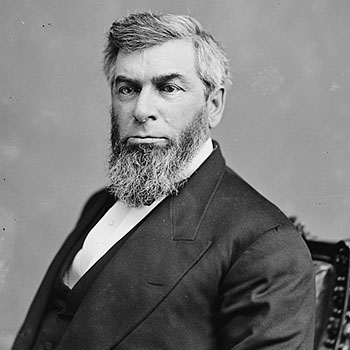
Immediately, Francis Minor appealed the ruling. Three months later in May 1873, the case was presented before the Missouri Supreme Court, again at the Old Courthouse in St. Louis. The result would be the same, and Francis Minor then filed a final appeal to bring the case before highest court in the land, the United States Supreme Court.
The case was argued in Washington D.C. two years later in February 1875. Unlike the previous cases that essentially ruled in favor of the Missouri Constitution and its use of the word “male”, the Supreme Court’s ruling was more definitive. With a unanimous 9-0 decision, the Supreme Court ruled that neither the Constitution nor the 14th Amendment granted any citizen the right to vote as Francis Minor theorized.
In the court’s opinion, written by Chief Justice Morrison Waite, the point is clearly made:

Despite defeat, Virginia and Francis Minor continued the fight for the remainder of their lives. In 1879, Virginia Minor was elected President of the Missouri branch of the National Woman Suffrage Association. She refused to pay her taxes, argued for equality in newspapers, testified before the United States Senate, and on the one-hundred year anniversary of the signing of the Declaration of Independence; she joined her fellow suffrage leaders Elizabeth Cady Stanton, Susan B. Anthony, and several others in signing the Declaration of Rights of the Women of the United States.
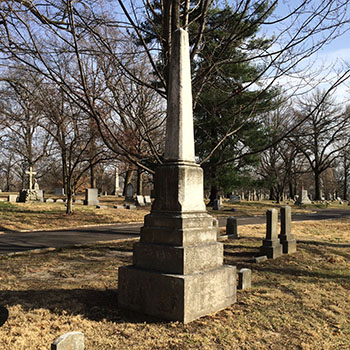
Virginia Minor died in St. Louis on August 14, 1894. Because she found the clergy hostile to her cause, her funeral was held at the Minor home without religious service or religious figures present. She willed $1,000 to her friend and colleague Susan B. Anthony in gratitude for the time and money she had expended towards their common cause. Peculiarly, she also willed two nieces $500 each on the provision that they never marry. Furthermore, if one of them did decide to wed, her share would transfer to the other.
Virginia Louisa Minor is buried in Bellefontaine Cemetery next to her husband and their only child. Coincidentally, in a unmarked grave just across the cemetery road, less than two-hundred feet away, sits the grave of her adversary Reese Happersett.
On August 18, 1920, sixteen years and four days after Virginia Minor died, the 19th Amendment to the United States Constitution was ratified. The amendment prohibited any United States citizen from being denied the right to vote on the basis of sex, and it effectively overruled the decision handed down in Minor v. Happersett.
![]()
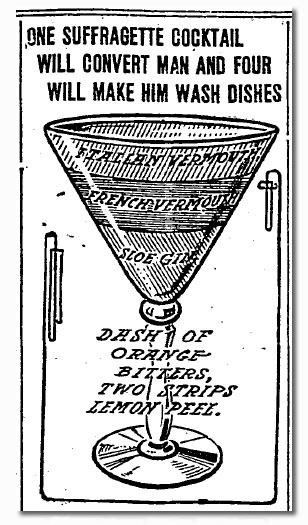
As a history nerd, the women’s suffrage movement is one that has always fascinated me. It’s a perfect vehicle to explain why I love history. Since I wasn’t alive during the time to see it with my own two eyes, I yearn to study and understand why something as completely unthinkable to me as denying a woman the right to vote was acceptable as recently as one-hundred years ago.
Another aspect of women’s suffrage that’s interesting is its close relation to alcohol and the temperance movement that occurred at the same time. That’s a subject for another post, but it’s an interesting conversation I’ve had more than once since I started researching and writing this one. Just a few weeks ago, I sipped a Manhattan cocktail and listen to a brilliant woman explain to me that “a major reason why the 19th Amendment passed is because of the same women who had already effectively organized and campaigned to help push through the 18th Amendment.”
In other words, women became very good at politics since the days of the St. Louis Ladies’ Union Aid Society. Before achieving the right to vote, they honed their craft by organizing into a political force and making Prohibition a reality in the United States.
I should hold a grudge about that, but I don’t. Prohibition was a complete failure, but something had to be done about the crazy drunkenness going on in the 19th and early 20th centuries. But again, that’s a story for another post.
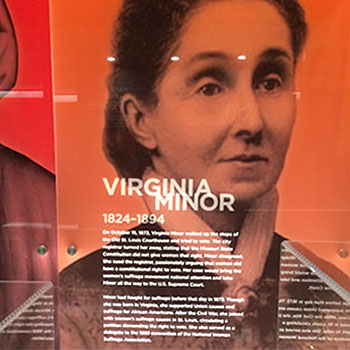
However, I found no record of Virginia Minor being involved with the temperance movement, so I’m going to assume that she wouldn’t mind sitting down with me to throw back a glass of wine, a cup of punch, or maybe even a sip of whiskey.
And remarkably, I stumbled upon a drink created by a St. Louis bartender that fits the theme of this post. A recipe for a concoction named the “The Suffragette” appears in the May 9, 1909 issue of the St. Louis Post-Dispatch. It was invented by a local bartender named “Pop” Harris. Simple to make and containing several ingredients I had on hand, I set out to make it myself and drink a couple on the front porch.
Although the name of the drink is perfect (this is the first time one term has adequately defined both the history and drink subject for one of my posts), I had two problems that I couldn’t shake from my mind as I sipped.
First if all, I kept thinking how pissed Virginia Minor would be at how it was advertised in the Post-Dispatch: “One suffragette cocktail will convert man and four will make him wash dishes”. The second issue is that it just doesn’t have enough alcohol. When I take the time to mix a fancy cocktail, I want to be hit on that first sip. Rittenhouse Rye (my choice for the main ingredient in a Manhattan) is 100 proof. The cheap sloe gin I had on hand to make the occasional sloe gin fizz is only 30 proof. Sweet and dry vermouth (which are simply fortified wines) are great compliments to base spirits, but they certainly aren’t going to help knock you off your chair. I believe I’m going to try to improve this drink on my own, perhaps making my own sloe gin, or by adding a bit of Hayman’s Old Tom, which helped a bit with my second pour.
In its current state, I doubt even four suffragettes could get me drunk, and that’s just fine. I was already on board with Virginia Minor before I drank the first one. And I’ll leave the dishes for tomorrow.
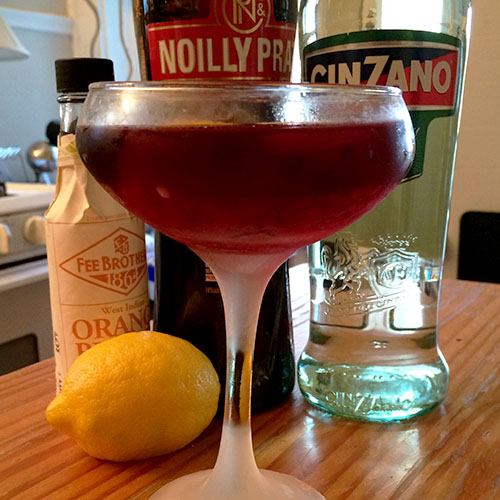
Note: The original title of this post was “The Suffragette”. After being informed (by more than a few people) that the correct term for Virginia Minor should be “Suffragist”, and agreeing with the argument that the suffix “ette” connotes smallness (which Virginia Minor certainly wasn’t), the title was updated to “The Suffragist”.

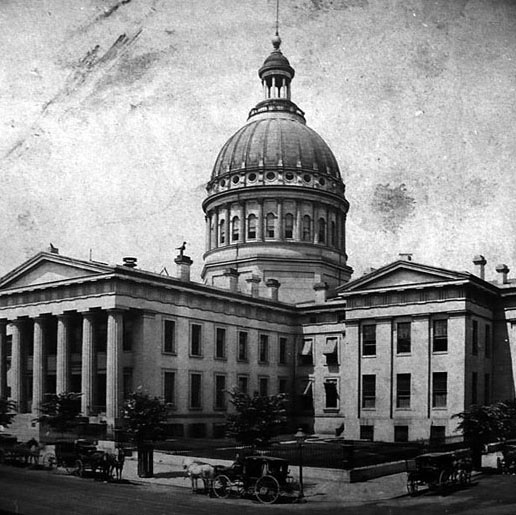
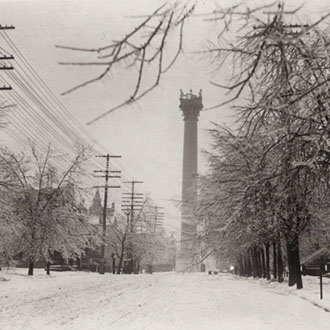
Really interesting–Thanks for sharing.
Thank you for this history of VLM and noteworthy comments.
I choose to think she would be sitting with us with a drink in hand.
I would like to claim her as my relative but haven’t found the proof as yet
… but I’m still searching…..
She is of the Doodes line of genealogy.
http://alum.wpi.edu/~p_miner/Miner0.html#TMdoodes
Great Story. Love your articles, especially the appreciation of our STL history.